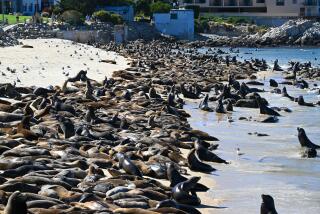Bit by Bit, Ancient Society Reemerges on Island Off Ventura County Coast
- Share via
Navy archeologist Steve Schwartz stands in a room on far-off San Nicolas Island, holding a heavy stone bowl. He is very likely one of the first people to touch it since a Nicoleno Indian ate dinner from it thousands of years ago.
This item--and hundreds of others that constitute some of the last remaining evidence of a long-gone society--are his responsibility.
It is he who is trying to analyze results from 12 years of excavation to learn more about a society that left traces only here, 60 miles off the Ventura County coast.
The room is full of shelves, covered with items made up to 10,000 years ago. Fishhooks, mortar, bits of basket, seaweed rope, seemingly unidentifiable bits of bone that Schwartz points to as a pestle, or a knife, or, if even he doesn’t know, simply a “tool.”
It’s a museum-worthy collection of parts, bagged, tagged and stacked onto shelves a 10-hour boat ride from the mainland, in a storeroom on a wind-swept rock that has never been home to more than several hundred residents in the nearly 10,000 years it has been populated.
“It’s a pretty awe-inspiring thing to know you uncovered something that’s been sitting there for thousands of years,” Schwartz said. “No one has ever seen them.”
Schwartz was hired by the Navy a dozen years ago to meet federal environmental requirements and has become the expert on the island, one of the southern Channel Islands.
It is remote. But he finds he doesn’t mind it. He spends only a quarter of his time on the island, a missile-testing site where about 250 Navy personnel live and work. Sometimes he spends a day or two; sometimes he takes the plane there in the morning and heads back in the afternoon.
“It’s a nice escape, a beautiful place,” he said. “You can be reached, but people think you can’t.”
Schwartz knows more than just about anyone about the Nicoleno, a society--the latest of two that lived on the island--that began perhaps 3,000 years ago and was eventually wiped out in the 19th century.
“Steve knows the archeology there and the sites better than anyone I’ve ever seen,” said Patricia Martz, a professor of archeology at Cal State Los Angeles, who does regular research on the island. “I don’t know how he does it.”
One of the first things he did when he arrived was to find journal accounts of the Nicoleno. He is also there when the Navy needs to build or has plans for a particular spot.
“It’s a lot of detective work,” Schwartz said. “That’s the most fun of it. . . . All we ever know is what we dig up.”
Thanks to those artifacts lining Schwartz’s shelves, there are clues to what the people were like and how they lived.
He believes that the Nicoleno sailed here and that they had perhaps yearly contact with civilizations on other islands.
They were water people, Schwartz said, that is obvious in the cave paintings of whales and sharks.
They relied on the sea but rarely left the island. They had very little wood, because there are few trees. There was little good stone for making arrowheads.
The islanders must have had a good life, Schwartz said. There was plenty of food--abalone and mussels that could be plucked from the rocks. The Nicoleno built shelters out of whale bones tucked into holes that would have kept them out of the island’s fierce winds.
Schwartz came to the island after a stint working for the Army Corps of Engineers and studies at Cal State L.A., Cal State Long Beach and Cal Poly Pomona.
His 11-year-old daughter lives with her mother in Ojai. She has never been to the island he knows so well--the Navy doesn’t allow children.
It is something he wants to share with her. “It’s the story of the human condition basically,” is how John Johnson, curator of anthropology at the Santa Barbara Museum of Natural History, puts it.
It’s also the simple challenge of solving a mystery.
“It’s been a really great opportunity,” Schwartz said. “There are very few places anymore where you can come in and pretty much nothing is known.”
More to Read
Sign up for Essential California
The most important California stories and recommendations in your inbox every morning.
You may occasionally receive promotional content from the Los Angeles Times.













